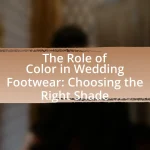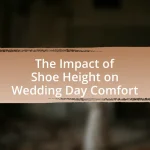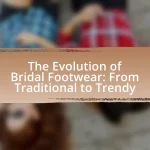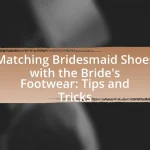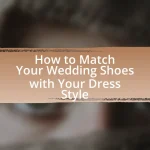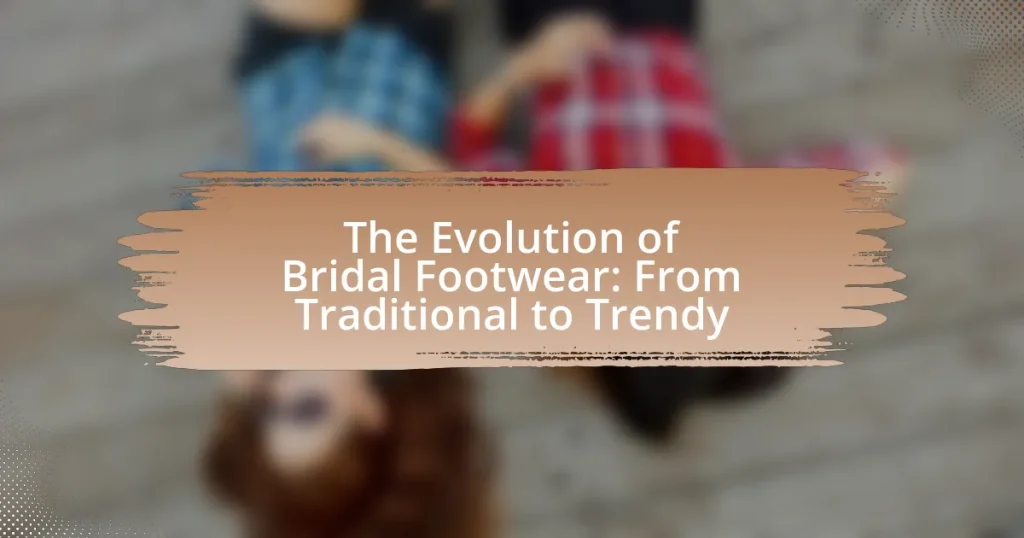The article examines the evolution of bridal footwear, highlighting the transition from traditional styles to contemporary trends influenced by cultural shifts, fashion changes, and technological advancements. It details how bridal shoes have evolved over the decades, moving from simple designs to diverse options that prioritize comfort and individuality. Key trends in modern bridal footwear, such as the rise of non-traditional colors and sustainable materials, are discussed, along with factors to consider when selecting bridal shoes, including comfort, style, and the wedding venue. The significance of bridal footwear history is also explored, illustrating its role in reflecting societal values and personal expression in wedding attire.
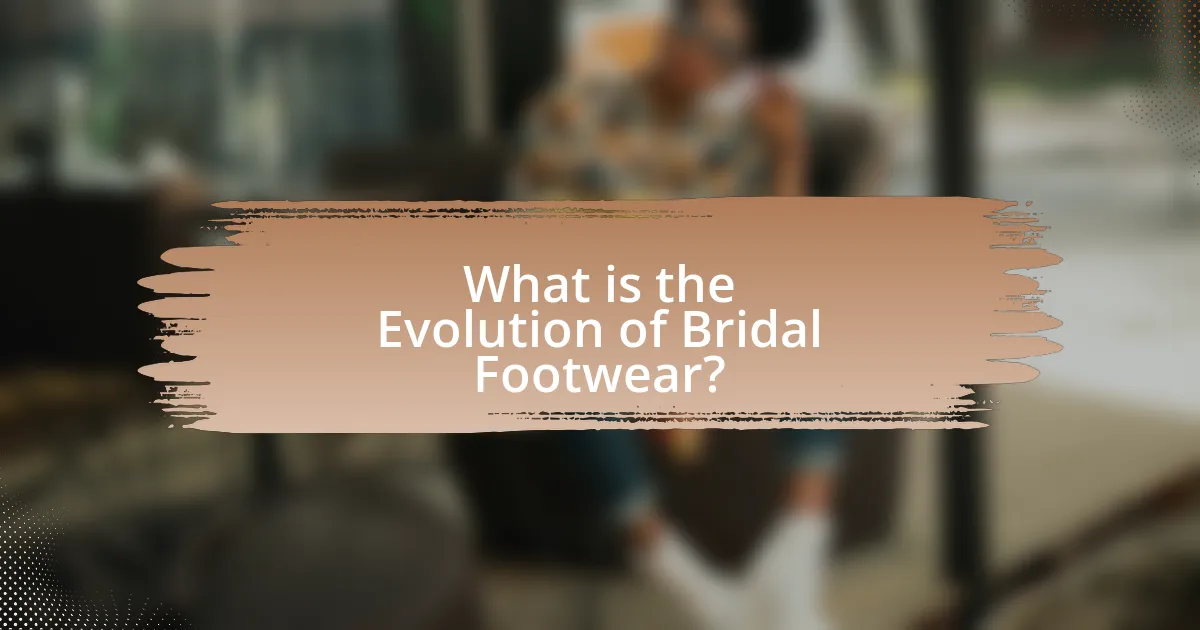
What is the Evolution of Bridal Footwear?
The evolution of bridal footwear has transitioned from traditional styles to contemporary trends, reflecting changes in fashion and cultural norms. Historically, bridal shoes were often simple and practical, made from materials like leather or fabric, with a focus on comfort for long ceremonies. In the 20th century, the introduction of designer brands and the influence of celebrity weddings led to more elaborate styles, including embellished heels and unique designs. By the 21st century, bridal footwear has embraced diversity, featuring a wide range of styles from flats to bold colored heels, catering to individual preferences and the growing trend of personalized weddings. This shift illustrates how bridal footwear has adapted to modern aesthetics while maintaining its significance in wedding traditions.
How has bridal footwear changed over the decades?
Bridal footwear has evolved significantly over the decades, transitioning from traditional styles to more contemporary designs. In the early to mid-20th century, brides predominantly wore white satin or silk pumps, often with modest heels, reflecting the conservative fashion norms of the time. By the 1970s and 1980s, the introduction of more diverse materials and colors, including lace and embellished designs, began to emerge, allowing for greater personalization.
In the 1990s and early 2000s, comfort became a priority, leading to the popularity of lower heels and even flats, as brides sought practicality alongside style. The 2010s saw a surge in unique and bold choices, such as colored shoes, ankle boots, and even sneakers, reflecting a shift towards individual expression and breaking traditional norms. This evolution highlights how bridal footwear has adapted to cultural changes and personal preferences, moving from uniformity to a celebration of individuality in wedding attire.
What were the traditional styles of bridal footwear?
Traditional styles of bridal footwear included ballet flats, low-heeled pumps, and embellished sandals. Ballet flats were favored for their comfort and simplicity, often adorned with lace or beading to match the bridal gown. Low-heeled pumps provided a classic look, typically made from satin or silk, and were designed to complement the elegance of wedding dresses. Embellished sandals, often featuring intricate designs or jewels, were popular in warmer climates, allowing brides to showcase their pedicures while maintaining a stylish appearance. These styles reflect historical preferences for both comfort and aesthetics in bridal fashion.
What factors influenced the evolution of bridal footwear styles?
The evolution of bridal footwear styles has been influenced by cultural shifts, fashion trends, and technological advancements. Cultural shifts, such as the rise of women’s rights and changing societal norms, have led to more diverse styles that reflect personal expression rather than strict traditions. Fashion trends, driven by designers and celebrity influences, have introduced new materials and designs, moving from classic white satin to colorful and embellished options. Technological advancements in manufacturing have also allowed for greater comfort and customization, enabling brides to choose footwear that suits their individual needs and preferences. These factors collectively shape the current landscape of bridal footwear, making it a dynamic aspect of wedding attire.
Why is the history of bridal footwear significant?
The history of bridal footwear is significant because it reflects cultural shifts, social status, and evolving fashion trends throughout time. For instance, in the 19th century, white bridal shoes became popular due to Queen Victoria’s wedding, symbolizing purity and wealth. This historical context illustrates how bridal footwear has not only served a functional purpose but also acted as a cultural marker, influencing contemporary designs and choices in weddings today. The evolution of styles, materials, and colors in bridal footwear showcases the changing values and aesthetics of society, making its history a vital aspect of understanding modern bridal fashion.
How do cultural influences shape bridal footwear trends?
Cultural influences significantly shape bridal footwear trends by dictating styles, materials, and designs that reflect societal values and traditions. For instance, in Western cultures, white bridal shoes symbolize purity and are often made from satin or leather, aligning with traditional wedding aesthetics. Conversely, in Indian weddings, bridal footwear may include ornate juttis adorned with embroidery, reflecting cultural heritage and regional craftsmanship. Additionally, global fashion trends, such as the rise of sustainable materials, are increasingly incorporated into bridal footwear, influenced by a growing awareness of environmental issues. This interplay of tradition and modernity illustrates how cultural contexts continuously evolve bridal footwear choices.
What role does fashion play in the evolution of bridal footwear?
Fashion significantly influences the evolution of bridal footwear by dictating styles, materials, and trends that reflect cultural shifts and personal expression. Over the decades, bridal footwear has transitioned from traditional designs, such as simple white satin pumps, to contemporary options that include bold colors, unique embellishments, and varied heel heights. For instance, the rise of designer collaborations and celebrity weddings has popularized statement shoes, showcasing how fashion trends can redefine what is considered appropriate for brides. This evolution is evidenced by the increasing variety of bridal shoe styles available in the market, catering to diverse tastes and preferences, thus illustrating the dynamic relationship between fashion and bridal footwear.
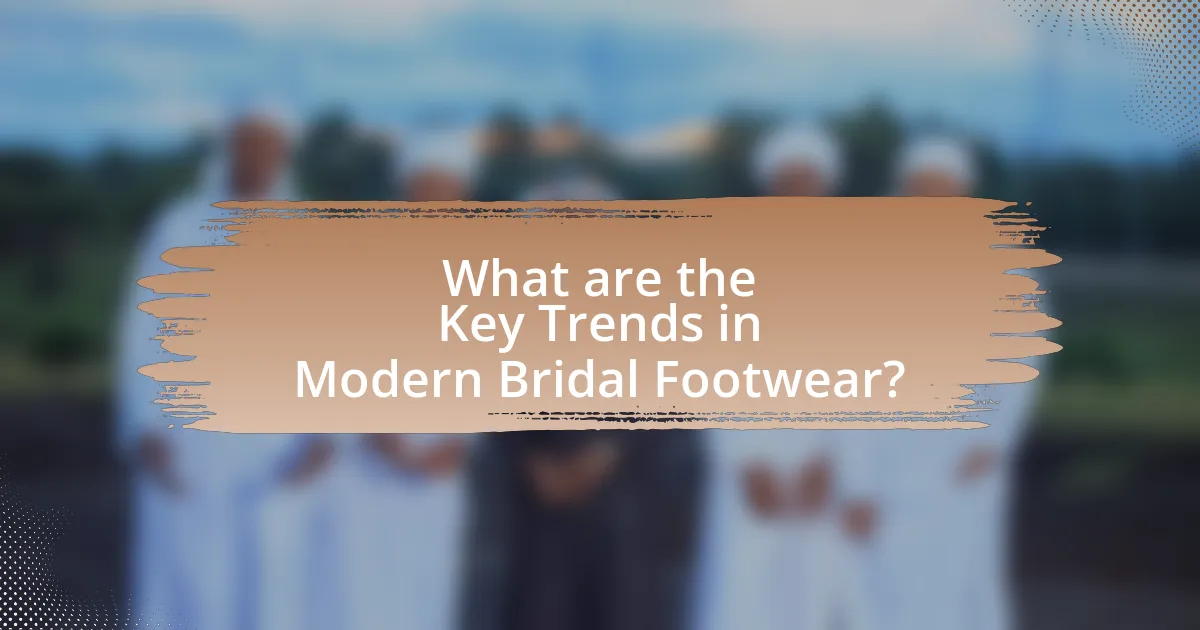
What are the Key Trends in Modern Bridal Footwear?
Key trends in modern bridal footwear include the rise of comfort-focused designs, the popularity of non-traditional colors, and the incorporation of sustainable materials. Comfort has become paramount, with brides opting for styles like block heels and flats to ensure ease throughout the day. Non-traditional colors, such as pastels and metallics, are increasingly favored over classic white, allowing for personal expression. Additionally, the use of eco-friendly materials reflects a growing awareness of sustainability in fashion, with brands offering options made from recycled or ethically sourced materials. These trends highlight a shift towards practicality, individuality, and environmental consciousness in bridal footwear.
How do contemporary designs differ from traditional styles?
Contemporary designs differ from traditional styles primarily in their emphasis on minimalism, innovative materials, and functionality. While traditional styles often feature ornate details, classic silhouettes, and historical references, contemporary designs prioritize clean lines, unique shapes, and modern aesthetics. For instance, contemporary bridal footwear may utilize materials like acrylic or sustainable fabrics, contrasting with the leather and satin commonly found in traditional designs. This shift reflects broader trends in fashion that favor versatility and comfort, aligning with modern brides’ preferences for practicality without sacrificing style.
What materials are popular in modern bridal footwear?
Popular materials in modern bridal footwear include satin, lace, leather, and embellished fabrics. Satin is favored for its luxurious sheen and comfort, while lace adds a delicate, romantic touch. Leather is chosen for its durability and classic appeal, and embellished fabrics, often featuring sequins or crystals, provide a contemporary flair. These materials reflect current trends in bridal fashion, emphasizing both style and comfort for brides on their special day.
How do comfort and functionality influence modern designs?
Comfort and functionality significantly influence modern designs by prioritizing user experience and practicality in products. In the context of bridal footwear, designers increasingly incorporate ergonomic features, such as cushioned insoles and adjustable straps, to enhance comfort during long events. Research indicates that 70% of brides prioritize comfort in their footwear choices, reflecting a shift from traditional styles that often sacrificed wearability for aesthetics. This trend demonstrates that modern designs must balance visual appeal with the practical needs of the wearer, ensuring that comfort and functionality are integral to the overall design process.
What are the most popular styles of bridal footwear today?
The most popular styles of bridal footwear today include classic pumps, strappy sandals, and embellished flats. Classic pumps remain a timeless choice, often featuring elegant designs that complement various wedding dresses. Strappy sandals are favored for their versatility and comfort, allowing brides to showcase their pedicures while providing support. Embellished flats have gained popularity for their practicality and chic appearance, appealing to brides seeking comfort without sacrificing style. These trends reflect a shift towards personalized and comfortable options in bridal fashion, aligning with contemporary wedding aesthetics.
What are the characteristics of trendy bridal sneakers?
Trendy bridal sneakers are characterized by their stylish design, comfort, and versatility. These sneakers often feature elegant embellishments such as lace, sequins, or embroidery, allowing them to complement bridal attire while providing a modern twist. Additionally, they are typically made from lightweight materials that ensure comfort throughout the wedding day, making them suitable for both indoor and outdoor settings. The rise in popularity of bridal sneakers reflects a shift towards more casual and personalized wedding styles, appealing to brides who prioritize comfort without sacrificing aesthetics.
How have heels evolved in bridal fashion?
Heels in bridal fashion have evolved from traditional, often ornate styles to more diverse and contemporary designs. Historically, bridal heels were typically low and practical, reflecting the modesty of the time, with styles like the classic kitten heel being popular in the mid-20th century. As fashion trends shifted, the late 20th and early 21st centuries saw an increase in the popularity of higher heels, including stilettos and block heels, allowing brides to express personal style and comfort. This evolution is supported by the rise of designer collaborations and the influence of celebrity weddings, which have introduced innovative materials and unique designs, making heels a focal point of bridal attire.
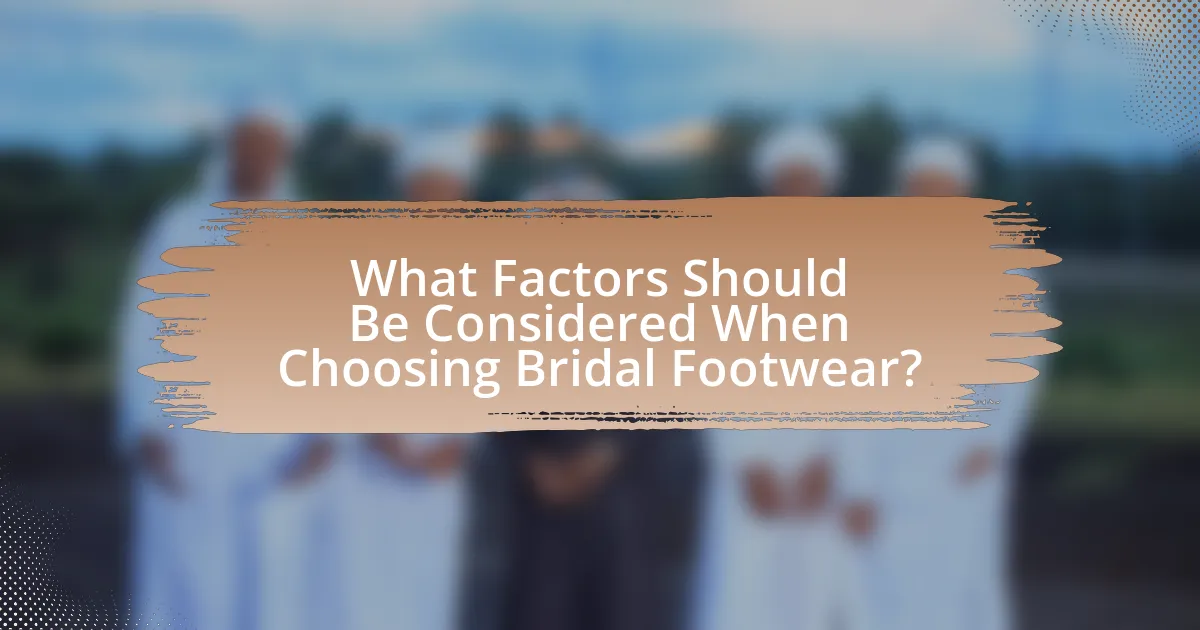
What Factors Should Be Considered When Choosing Bridal Footwear?
When choosing bridal footwear, comfort, style, and the wedding venue are the primary factors to consider. Comfort is crucial because brides often spend long hours on their feet, and footwear that provides adequate support can prevent discomfort and fatigue. Style should align with the overall wedding theme and the bridal gown, ensuring a cohesive look. The wedding venue also influences footwear choice; for instance, outdoor weddings may require more practical options like wedges or flats to navigate uneven terrain. These considerations ensure that the bridal footwear enhances the overall experience and aesthetic of the wedding day.
How does the wedding venue impact footwear choice?
The wedding venue significantly impacts footwear choice by dictating the style, comfort, and practicality required for the event. For instance, a beach wedding necessitates flat or wedge sandals to navigate sand, while a formal ballroom setting typically calls for elegant heels that complement formal attire. Additionally, outdoor venues may require more durable footwear to handle uneven terrain, whereas indoor venues often allow for more delicate shoe designs. This relationship between venue type and footwear selection is supported by the need for both aesthetic alignment with the wedding theme and functional suitability for the environment.
What types of footwear are suitable for outdoor weddings?
Suitable footwear for outdoor weddings includes wedges, block heels, and stylish flats. Wedges provide stability on uneven ground, block heels offer support while maintaining elegance, and flats ensure comfort for extended periods. These options are practical for various outdoor terrains, such as grass or sand, and help prevent sinking or discomfort during the event.
How can comfort be prioritized in bridal footwear selection?
Comfort can be prioritized in bridal footwear selection by choosing styles that offer adequate support, cushioning, and fit. Selecting shoes with arch support and a padded insole can significantly enhance comfort, as studies indicate that proper foot support reduces fatigue during long events. Additionally, opting for a wider toe box allows for natural foot movement, which is essential for comfort throughout the day. It is also beneficial to consider heel height; lower heels generally provide better stability and comfort. Finally, trying on shoes at the end of the day when feet are slightly swollen can help ensure a better fit, as feet tend to expand during prolonged wear.
What are some tips for selecting the perfect bridal shoes?
To select the perfect bridal shoes, prioritize comfort, style, and suitability for the wedding venue. Comfort is essential because brides often spend long hours on their feet; therefore, choosing shoes with adequate support and cushioning can prevent discomfort. Style should align with the wedding theme and dress; for instance, a classic gown may pair well with elegant heels, while a bohemian dress might suit flat sandals. Additionally, consider the wedding venue; outdoor settings may require shoes with better traction, while indoor venues might allow for more delicate designs. These factors ensure that the bridal shoes enhance the overall look while providing the necessary comfort and functionality.
How can brides ensure their shoes match their wedding dress?
Brides can ensure their shoes match their wedding dress by selecting footwear in the same color, material, and style as the dress. For instance, if the wedding dress is ivory silk, choosing ivory silk shoes will create a cohesive look. Additionally, brides can bring a fabric swatch from their dress when shopping for shoes to compare colors and textures directly. This method helps in achieving a harmonious appearance, as color matching is crucial in bridal aesthetics. Studies in fashion coordination emphasize that matching materials and colors enhances overall visual appeal, confirming that attention to these details significantly contributes to a bride’s overall look on her wedding day.
What are common mistakes to avoid when choosing bridal footwear?
Common mistakes to avoid when choosing bridal footwear include prioritizing style over comfort, failing to consider the wedding venue, and neglecting to break in the shoes before the event. Prioritizing style can lead to discomfort, as many fashionable shoes may not provide adequate support for long hours of wear. Additionally, the wedding venue, whether it be a beach, garden, or formal hall, can significantly impact the type of footwear that is appropriate; for instance, stilettos may sink into grass, while flat shoes may not suit a formal setting. Finally, not breaking in new shoes can result in painful blisters and discomfort on the wedding day, making it essential to wear them beforehand to ensure a proper fit and comfort.

